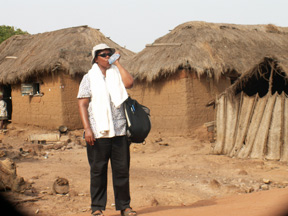 |
Valda Boyd Ford at the Buduburam Refugee Camp in Ghana. |
Ford, director of UNMC’s Community and Multicultural Affairs, has been working with Unite for Sight, an organization dedicated to health promotion and disease prevention. Today, she outlines a “typical” day at the Buduburam Refugee Camp.
A day in camp
The call for prayer echoes in the background but it is not the reason I am already awake at 5 a.m. Nor are the crowing roosters and overburdened trucks thundering along the main road contributors to my wakefulness. The day has not yet dawned but my day has begun. You see, the temperature has begun to rise in the wee hours of the morning and that, along with the fact that there is no movement of the ceiling fan and therefore no breeze, is the reason the sandman has left the vicinity.
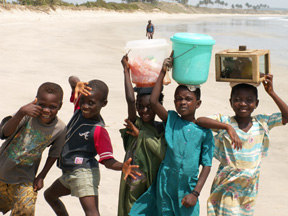 |
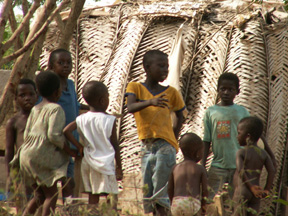 |
Some of the children in Ghana. |
I start my cleansing and cooling ritual with the bucket of water I left in the shower. It is not a good idea to assume that the “shower” will work owing to the regular depletion of water by four Western women at the guest house. Even though the large black tanks are filled twice weekly (or more) there is no way to tell when the tank is nearly empty so the system is to wait until the tank yields no more precious water and call for the water truck. This morning the “shower” is working so I take advantage of the distressingly low pressure shampoo (though I am too tall for the showerhead). I finish my bath using the bucket and plastic cup, replace the water in the bucket, and try to move slowly to convince my body that it is no longer hot.
My clothes are laid out on the chair and I try to dress in the dark or by flashlight. Some days “the current” is working and I can see what I am doing but, more likely, I am finding my way in semi-darkness. Then I have a drink from one of the many bags of water I keep in the room – always careful to determine my future proximity to a Western toilet.
By now the morning is filled with the sounds of people moving around (not my fellow volunteers) and a series of announcements via loudspeakers has begun. Today there is a plea for help in locating a family member, a job announcement for a history teacher, and a listing of camp activities – usually involving UNHCR repatriation issues. After assuring myself that the announcements are not specifically for my attention I assess my environment and find that the sunlight has brought more heat so I leave my room for the coolness of the Internet cafe.
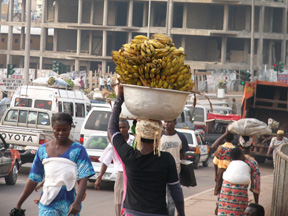 |
A woman in Kumasi carries a basket of bananas. |
Today, like most days, is a clinic day. As we walk to the clinic we wonder where we will be today. On the first day we had a moderately long discussion of how best to set up the room and how to mark the floors with tape to make visual acuity assessments. We returned day two to find that we could not get in the room as the newly arrived Ivory Coast refugees are sleeping on the floor in our “clinic.”
There are at least 10 patients waiting, hoping to be first in line, and fearful that we will go away or all of our supplies will be “finished” as they say. After about a half-hour we are told by the top administrator that we are not refugees and we should not be sitting on the steps (though there is no other obvious place to sit). However, upon his arrival, chairs have materialized and people have been told that we will use their offices while we wait for a more permanent resolution. Over time we are given a new room and the set-up process resumes.
We have a local volunteer who has taken over the powerful position of controlling “the list” and thereby controlling access to the clinic. While I am no expert, I would take odds that he was the poster child for hyperactive states. I am resigned to certain irregularities (from my perspective) but we have a conversation, again, about the nuances of “the list,” i.e., no matter if your name is number 40 on the list, if you are first to arrive, you are first to be seen. (Our “helper” likes to start calling the patients based on the numerical order of the list regardless of the fact that the people sitting outside may be at the end of the list).
Today I am helping with registration. On other days I might help with visual acuity screening using the illiterate “E” chart or do the physical assessment of the eye using a penlight and ophthalmoscope. The process is always interesting and challenging. Many people are looking for someone/anyone to actually listen to what they have to say so history-taking may include much more than a chronology of the eye condition or injury. Far too often the eye problem began with traumatic injuries during escape from the war zone or the inability to afford eye drops or surgery because all material possessions had to be left behind.
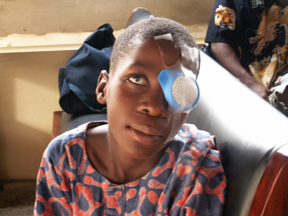 |
Fitzgerald, 10, is the group’s youngest cataract patient. |
Usually we find one or two people who have operable cataracts each day, but we find even more who have congenital or traumatic cataracts and eye ulcers that cannot be corrected. I am learning to recognize those conditions that cannot be helped by anything less than divine intervention, but it still pulls at my heart when the miracles of modern medicine offer no respite.
I also am in charge of finding the glasses to match the prescription the patients bring in hopes that we will solve the financial dilemma that is the norm. People bring in prescriptions they have held on to for as many as 12 years. We are not yet prepared to determine a lens prescription so if I ask them to go to a Ghanaian hospital or clinic to get a new prescription most cannot afford the fee of 45,000 cedis (about $5). So, my next challenge is to find a series of glasses that might fit using the Ford technique (that would be guessing mostly) that might help improve the patient’s vision. Amazingly and probably with divine intervention, I have been able to find about 80 percent of the prescriptions needed.